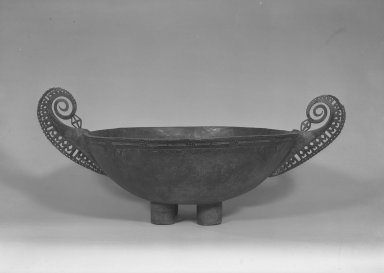
Artist:Matankol
Medium: Wood, parinarium nut paste
Geograhical Locations:
Dates:19th century
Dimensions: 23 x 56 1/2 x 36 3/4 in. (58.4 x 143.5 x 93.3 cm)
Collections:
Accession Number: 52.52
Image: 52.52_acetate_bw.jpg,
Catalogue Description: Large ceremonial food bowl and its four cylindrical legs are carved from a single piece of wood. Two handles are attached separately with parinarium paste and are purely ornamental. The handles project well beyond the rim of the bowl and terminate in spirals that curve inward and are supported by a strut in the shape of a diamond with crossbars. The outer edge of each handle is carved into an abstract openwork design consisting of circular, rectangular and diamond-shaped holes. Two wide parallel lines punctuated by fifteen small square motifs are carved in low relief around the perimeter of the bowl. Each square motif consists of a circle at the center surrounded by four hemispheres whose straight edges are not only denotated but also define the square. Another motif consisting of three inverted triangles appear directly below four of the square motifs just described. Condition: Fair. The handles have been broken and repaired in several places. There are numerous cracks along the bottom of the bowl, which run along the grain. Sections of the bowl, including the top edge, have been coated with a brown material; it is unclear whether this is original. One leg has wood missing from the bottom. Fragment of handle broken and repaired 12/87. From Accession Card: This food bowl of wood bas been blackened. It stands on four cylindrical legs and has two handles with open carving that have been gummed on to the bowl. The two handles rise in a spiral on their inner side to a height above the bowl while the outer edges of the handles are decorated with perforated carving in diamond and lozenge shapes. Two lines with fifteen small squares that have geometrical carvings in relief ring the outer rim of the bowl. Two conventionalized crocodile heads and arms are in relief on each side of the Bowl. Large bowls like this were used to eat from and extra ones were often made to be given away by the bride's family as their part of the wedding payments during ceremonies. The man's family returned currency in the form of dog's teeth of strings of shell rings. These feasts with the ceremonies occurred at betrothal, puberty, ear piercing, marriage, and birth, as well as at silver anniversaries. These ceremonies were all occasions for the numerous financial transactions which so interested the natives of the islands. Condition: Good though one handle has some of the top crest broken off; the other handle has a crack near the base and there are small cracks and nicks on the underside. One leg has wood missing from the bottom.